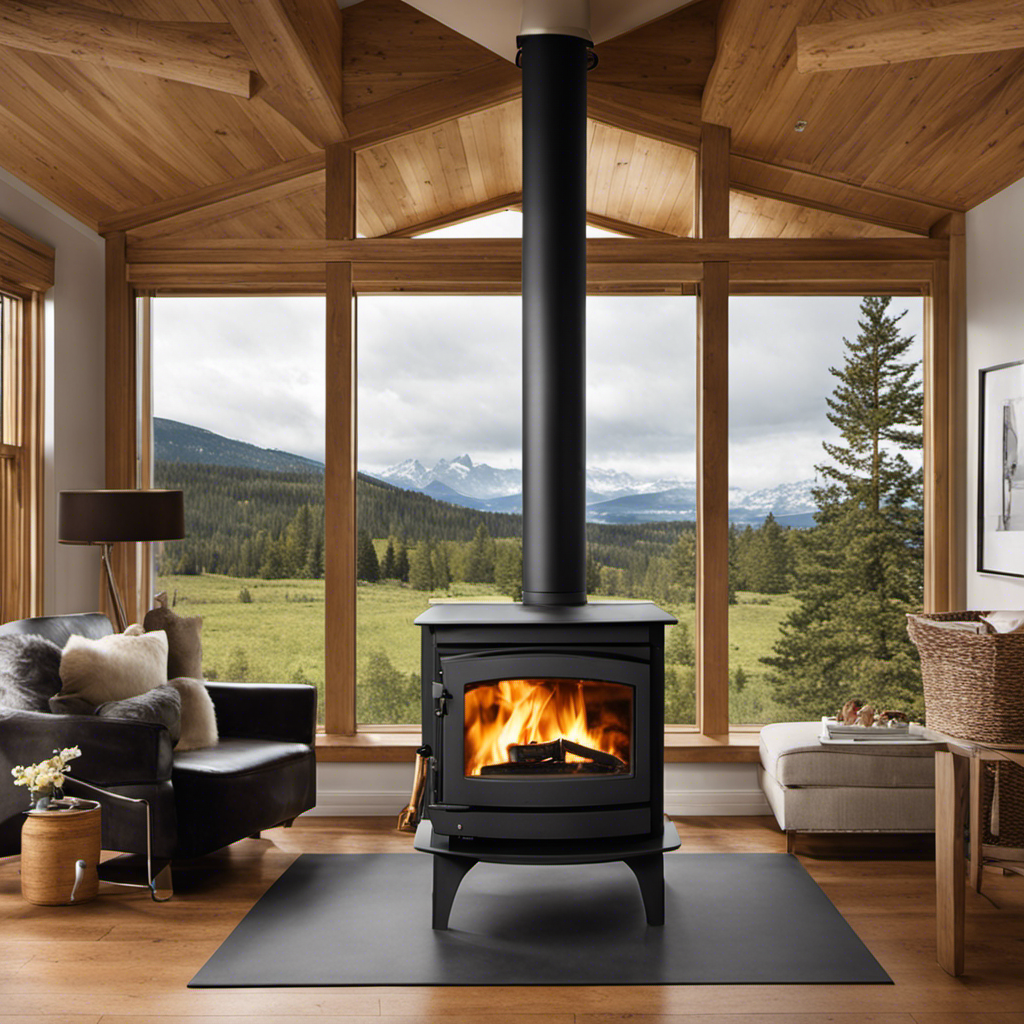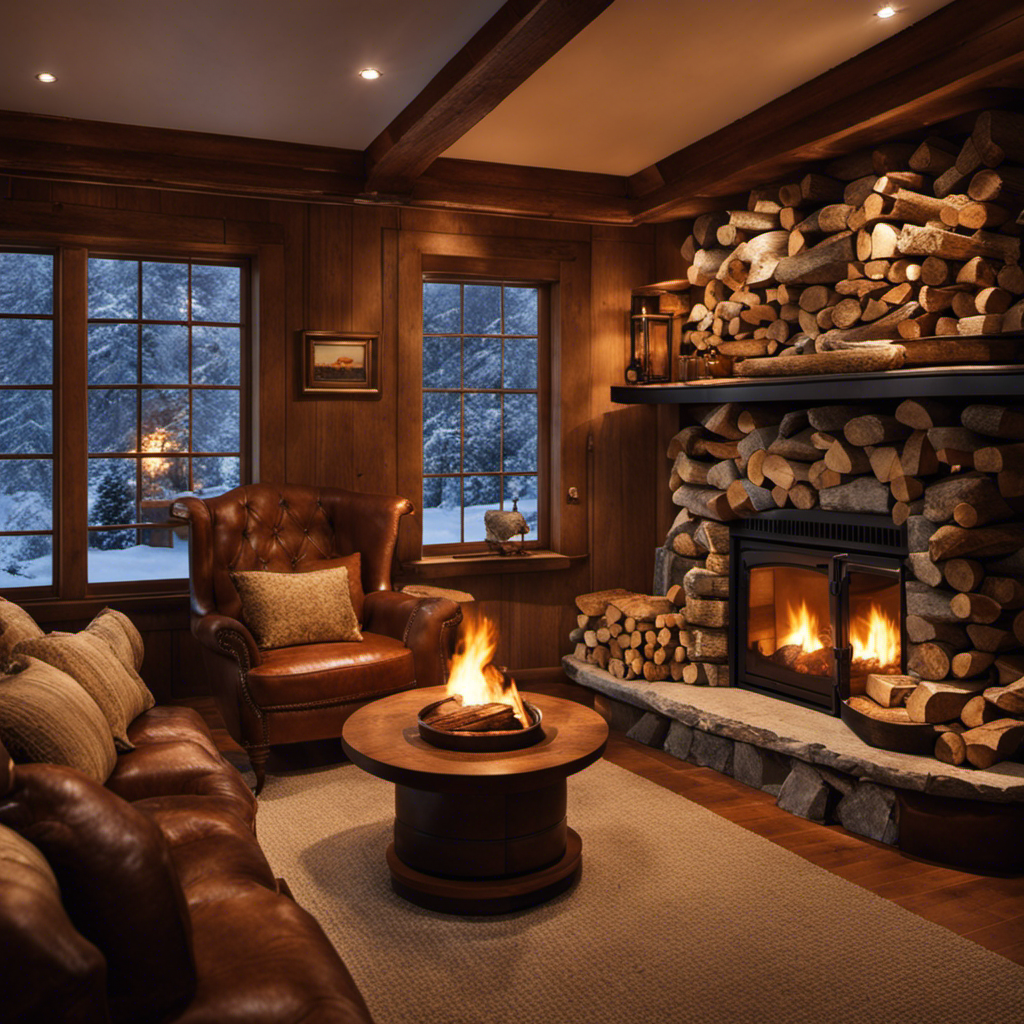Have you ever considered the correct distance between a wood stove and a wall? Allow me to outline the crucial safety guidelines and factors to consider when determining this gap.
Ensuring optimal heat distribution and efficiency is crucial for a safe and cozy home. In this article, we will explore the recommended minimum clearance for wood stove installation and provide you with tips to maintain the proper distance between your wood stove and the wall.
Key Takeaways
- Safety regulations and compliance for wood stoves include ensuring sufficient clearance around the stove to prevent combustible materials from catching fire.
- Proper wood stove placement is essential for optimal heat distribution, efficiency, and fire prevention.
- Following the manufacturer’s guidelines for recommended distance and safety considerations is crucial.
- Maintaining a minimum clearance of 36 inches between the stove and any combustible materials is important to reduce the risk of fire hazards.
Safety Regulations for Wood Stove Placement
I need to make sure that I follow the safety regulations for wood stove placement so that I can prevent any potential accidents. Fire safety precautions and building code compliance are crucial when it comes to the proper placement of a wood stove.
Firstly, it’s important to ensure that there’s sufficient clearance around the stove to prevent any combustible materials from catching fire. The specific clearance requirements can vary depending on the type of stove and the building codes in your area.
Additionally, it’s essential to have a non-combustible floor protector underneath the stove to prevent any heat transfer to the surrounding floor.
Following these safety regulations and guidelines will help ensure that my wood stove is placed correctly, minimizing the risk of any fire hazards or violations of building codes.
Factors to Consider When Determining Distance From the Wall
Taking into account the heat output and ventilation requirements, it’s important to consider both safety and efficiency when determining the distance from the wall for a wood stove. Here are four key factors to consider:
-
Fireproof materials: It’s crucial to ensure that the wall behind the wood stove is made of fireproof materials. This will prevent any risk of fire hazards and provide a safe environment for your home.
-
Ventilation requirements: Proper ventilation is necessary to ensure that the wood stove operates efficiently and safely. The distance from the wall should allow for adequate airflow and ventilation, preventing the buildup of harmful gases.
-
Clearance from combustible materials: The wood stove should be positioned at a safe distance from any combustible materials such as furniture, curtains, or carpeting. This will reduce the risk of accidental fires and ensure the safety of your home.
-
Manufacturer’s guidelines: Always refer to the manufacturer’s guidelines for the specific wood stove model you have. They’ll provide detailed instructions on the recommended distance from the wall and other safety considerations.
Considering these factors will help ensure the safe and efficient operation of your wood stove.
Now, let’s explore the optimal heat distribution and efficiency of a wood stove.
Optimal Heat Distribution and Efficiency
To achieve optimal heat distribution and efficiency, it’s important to position the wood stove at a safe distance from the wall and ensure proper ventilation. Proper ventilation is crucial for the safe operation of a wood stove. It allows for the release of combustion byproducts, such as carbon monoxide, while bringing in fresh air for efficient burning. Without adequate ventilation, the indoor air quality can be compromised, leading to health risks.
Additionally, the insulation surrounding the wood stove can greatly impact its efficiency. Good insulation helps to retain the heat produced by the stove, allowing it to radiate into the room rather than being lost to the surrounding walls.
By ensuring both proper ventilation and adequate insulation, you can maximize the performance and safety of your wood stove.
Now, let’s discuss the recommended minimum clearance for wood stove installation.
Recommended Minimum Clearance for Wood Stove Installation
Typically, wood stove manufacturers recommend a minimum clearance of at least 36 inches from combustible materials for safe installation. This recommended distance is crucial for fire prevention and ensuring the safety of your home.
Here are four key reasons why adhering to the recommended distance is paramount:
-
Reduced risk of accidental fires: By maintaining a proper clearance, you minimize the chance of combustible materials coming into contact with the stove, reducing the risk of a fire starting.
-
Enhanced heat distribution: A sufficient distance allows for proper air circulation around the stove, ensuring that heat is distributed evenly throughout the room and preventing overheating of nearby materials.
-
Easy maintenance and cleaning: Ample space around the stove makes it easier to clean and maintain, preventing the accumulation of debris that could pose a fire hazard.
-
Peace of mind: Following the recommended clearance provides peace of mind, knowing that you have taken all necessary precautions to protect your home and loved ones from potential fire hazards.
Tips for Maintaining Proper Distance Between Wood Stove and Wall
I always ensure that I maintain the proper distance between my wood stove and the wall, as it is essential for fire safety and peace of mind. The proper positioning of a wood stove is crucial to prevent potential hazards and ensure the efficient functioning of the appliance. Here are some tips for positioning your wood stove:
| Tips for Positioning | Fire Prevention Techniques |
|---|---|
| Maintain a minimum clearance of | Regularly clean the stove and |
| 36 inches between the stove | chimney to prevent buildup of |
| and any combustible materials. | creosote, which can lead to |
| Avoid placing the stove near | chimney fires. |
| curtains, furniture, or walls. | Use a heat-resistant wall |
| shield to protect the wall | |
| behind the stove. |
Frequently Asked Questions
Can I Place My Wood Stove Directly Against a Non-Combustible Wall?
Yes, you should not place a wood stove directly against a non-combustible wall due to heat distribution and clearance requirements. It is important to maintain proper clearance to ensure safety and prevent potential fire hazards.
Is It Safe to Install a Wood Stove Near a Window?
Installing a wood stove near a window requires careful consideration to ensure proper ventilation. It is crucial to follow safety guidelines and maintain the recommended distance to prevent any potential hazards or damage to the window.
What Are the Risks of Placing a Wood Stove Too Close to a Combustible Wall?
Placing a wood stove too close to a combustible wall poses serious risks. Safety guidelines for wood stove placement recommend maintaining a safe distance to minimize the risk of fire and ensure the safety of your home.
Can I Use a Heat Shield to Reduce the Required Clearance Between My Wood Stove and the Wall?
Yes, a heat shield can reduce the required clearance between my wood stove and the wall. It provides benefits like increased safety and improved heat distribution. Alternatively, other options like non-combustible materials can be used.
Are There Any Specific Guidelines for Placing a Wood Stove in a Mobile Home?
Mobile home wood stove regulations require specific guidelines for placement. Safety precautions include maintaining proper clearances between the stove and surrounding walls. It’s important to follow these guidelines to ensure the safety of your mobile home.
Conclusion
In conclusion, ensuring the proper distance between a wood stove and the wall is crucial for safety and optimal heat distribution. By following safety regulations and considering factors such as heat output and combustible materials, homeowners can create a safe and efficient wood stove installation.
Maintaining the recommended minimum clearance and regularly monitoring the distance will help prevent accidents and ensure a cozy and worry-free wood stove experience.
Stay warm, stay safe.
Logan’s affair with adventure began in childhood. He hailed from a small town where vast forests bordered one side and endless shores stretched on the other. His days were spent exploring uncharted woods, climbing tall trees, or listening to the tales of old sailors. This early immersion in a world brimming with stories and mysteries became the foundation of his passion for writing.











